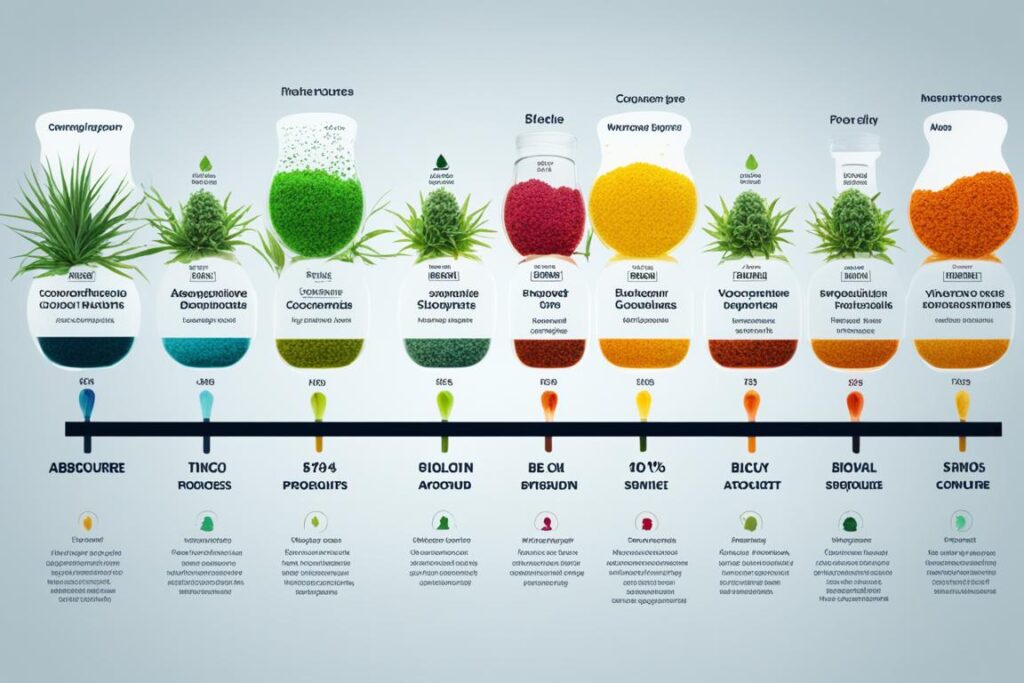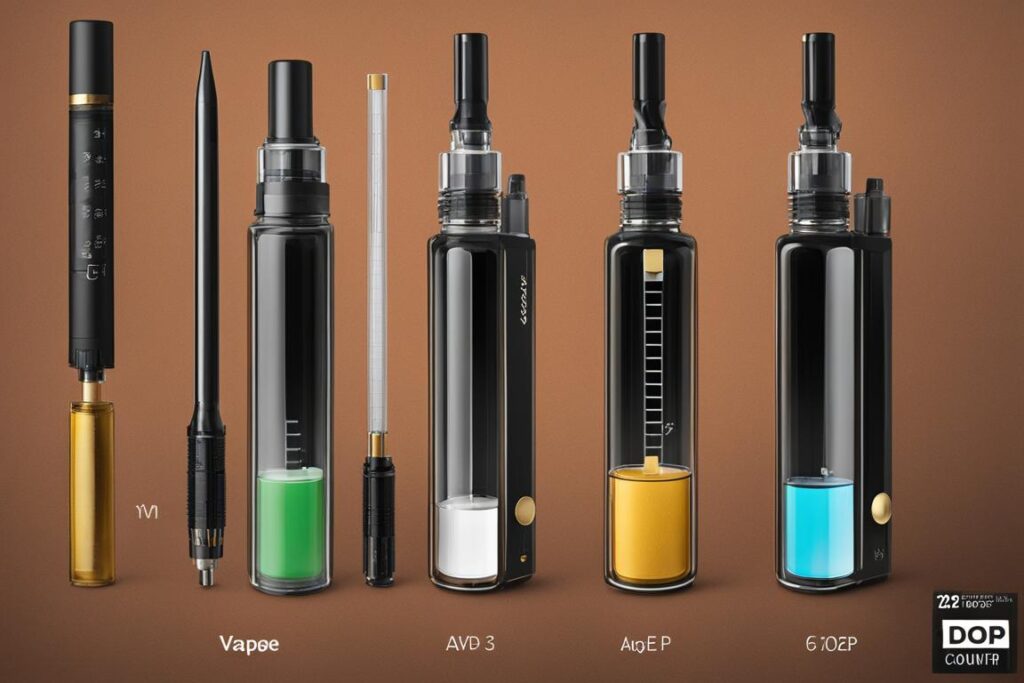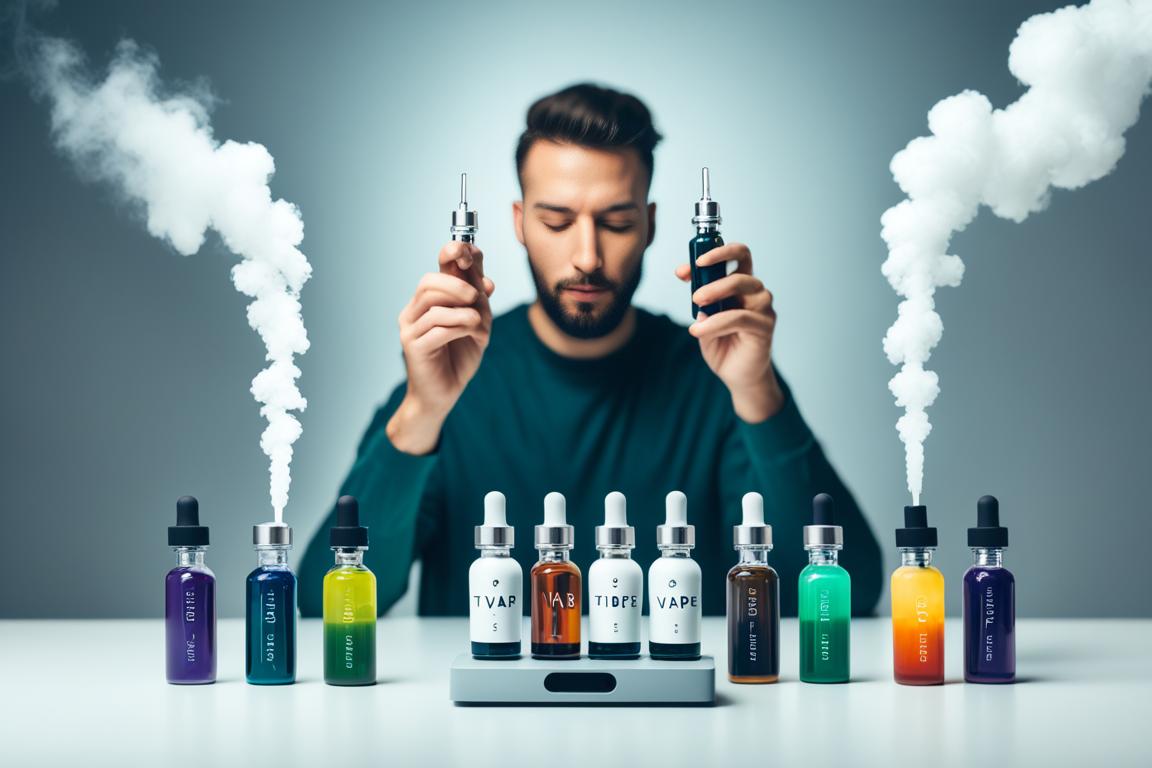Welcome to our guide comparing tinctures and vaping! Both methods offer unique benefits and usage options for CBD and THC consumption. Whether you’re seeking pain relief, anxiety management, or better sleep, understanding the differences between tinctures and vaping can help you make an informed decision.
Table of Contents
Toggle- Method of Consumption
- Bioavailability
- Onset Time
- Dosage and Control
- Safety Considerations for Vaping and Tinctures
- Choosing the Right Consumption Method
- Conclusion
- FAQ
- What is the primary difference between tinctures and vaping?
- Which method has a higher bioavailability?
- Which method has a faster onset time?
- Which method allows for more precise dosing?
- What should be considered for safety when using vaping and tinctures?
- How do I choose the right consumption method?
- Related posts:
Key Takeaways:
- Tinctures involve placing a few drops of CBD or THC under the tongue, while vaping requires inhaling through a vaporizer or vape pen.
- Vaping has a higher bioavailability and faster onset time compared to tinctures. Tinctures allow for more precise dosing and may be preferred by those who prefer not to inhale anything.
- Consider factors such as purpose, dosage, convenience, health considerations, and legal status when choosing between tinctures and vaping.
- Ensure safety by purchasing high-quality vape oil and following the manufacturer’s instructions for inhalation. Keep tinctures away from children.
- Find the consumption method that works best for your individual needs and preferences to maximize the benefits of CBD or THC.
Method of Consumption
When it comes to tincture vs vape, the main distinction lies in the method of consumption. CBD and THC vape involves inhaling through a vaporizer, while CBD and THC tinctures are taken by placing drops under the tongue. The difference in consumption methods results in variations in onset time and bioavailability.
Vaping bypasses the digestive system, allowing for faster absorption and higher bioavailability of CBD and THC. The inhalation of vapor delivers cannabinoids directly into the lungs and bloodstream, resulting in quicker and more potent effects. In contrast, need to be absorbed through the digestive system, which leads to a longer onset time.
The choice between CBD and THC vape vs tinctures depends on personal preferences and desired effects. Vaping is ideal for individuals seeking immediate relief and more pronounced effects, while tinctures are suitable for those who prioritize precise dosing and prefer not to inhale anything. Consider the onset time and bioavailability when deciding which method of consumption aligns best with your needs.
Bioavailability
Bioavailability is a crucial factor to consider when comparing tincture and vape methods for CBD and THC consumption. It refers to the amount of CBD or THC that enters the bloodstream and is available for the body to utilize. The bioavailability of a product determines how effectively it delivers the desired effects.
When it comes to bioavailability, vaping offers a significant advantage over tinctures. By inhaling CBD or THC through a vaporizer or vape pen, the compounds bypass the digestive system and enter the bloodstream directly. This direct route leads to higher bioavailability and quicker absorption, resulting in faster and more potent effects.
Tinctures, on the other hand, have a lower bioavailability compared to vaping. When consumed orally, tinctures need to be absorbed through the digestive system before entering the bloodstream. This process slows down the absorption and reduces the overall bioavailability of the CBD or THC.
To better understand the bioavailability disparities between tinctures and vaping, refer to the table below:
| Method of Consumption | Bioavailability | Advantages |
|---|---|---|
| Vaping | Higher | – Faster absorption – More potent effects |
| Tinctures | Lower | – Longer-lasting effects |
This table highlights how vaping maximizes bioavailability, leading to quicker and stronger effects. On the other hand, tinctures provide longer-lasting effects due to slower absorption and lower bioavailability.

By understanding the differences in bioavailability, individuals can make informed decisions about the consumption method that best suits their needs and preferences.
Onset Time
The onset time is an important factor to consider when choosing between CBD and THC vape and tinctures. Depending on your desired effects and preferences, the onset time can significantly impact your overall experience.
When it comes to vaping, the onset of effects is usually much quicker compared to tinctures. This is because when you vape CBD or THC, it is directly absorbed into the bloodstream through the lungs. As a result, you can start feeling the effects within minutes of inhaling.
In contrast, tinctures take a bit longer to take effect. After placing a few drops of the tincture under your tongue, it needs to be absorbed through the digestive system before entering the bloodstream. This process can take anywhere from 15 to 45 minutes.
It’s important to keep in mind that the onset time can vary depending on factors such as your metabolism, body weight, and the specific product you’re using. However, in general, vaping offers a faster onset of effects compared to tinctures.
Comparing Onset Time: Vaping vs Tinctures
| Vaping | Tinctures |
|---|---|
| Quicker onset of effects | Longer onset time |
| Effects felt within minutes | Effects felt within 15-45 minutes |
| Direct absorption through the lungs | Absorption through the digestive system |
Overall, if you’re looking for fast-acting effects, vaping may be the preferred option due to its quicker onset time. On the other hand, if you don’t mind waiting a bit longer for the effects to kick in, tinctures can still provide effective relief.
Dosage and Control
When it comes to dosage and control, tinctures offer a distinct advantage over vaping. The included dropper in tincture bottles allows for precise measurement and easy administration of the exact amount of CBD or THC consumed. This ensures consistent dosage and helps individuals find their optimal serving size for desired effects.
In contrast, determining the exact amount of CBD or THC consumed through vaping can be challenging, especially for beginners. Unlike tinctures, which provide a clear measurement system, vaping relies on inhaling vaporized cannabinoids through a device. This method does not offer the same level of control and precision when it comes to dosage.
It is important to note that dosage control is crucial when using CBD and THC products. Start with smaller amounts and gradually increase the dosage until the desired effects are achieved. Always follow the product’s recommended dosage guidelines and consult with a healthcare professional for personalized advice.
To further illustrate the difference between dosage and control in tinctures and vaping, consider the following table:
| Tinctures | Vaping |
|---|---|
| Allows for precise dosing with the included dropper | Difficult to measure exact amounts consumed |
| Easy to administer under the tongue | Inhaling vaporized cannabinoids |
| Offers better control and consistency | May result in variations in dosage |
As you can see from the table above, tinctures provide a more controlled and precise dosing method compared to vaping. This can be particularly beneficial for individuals who require specific dosages or have specific health concerns.

Safety Considerations for Vaping and Tinctures
When using CBD and THC vape, it is important to prioritize safety to ensure a positive experience. Here are some key safety considerations:
Vape Safety
- Purchase high-quality vape oil from reputable manufacturers to ensure the absence of harmful additives.
- Follow the manufacturer’s instructions regarding usage and maintenance of your vape device.
- Be aware of the potential risks associated with inhalation, such as lung irritation or damage.
- Start with a low dosage, especially if you are new to vaping, to avoid taking too much at once.
Tincture Safety
- Keep tinctures away from children, as they can be easily confused with ordinary food or beverages.
- Ensure that the dropper and bottle are properly sealed to prevent leakage or accidental ingestion.
- Be aware that tinctures may have an unpleasant taste for some individuals, but this can be mitigated by mixing them with food or drinks.
By following these safety considerations, you can enjoy the benefits of CBD and THC vape or tinctures with peace of mind.
Choosing the Right Consumption Method
When it comes to CBD and THC consumption, choosing the right method depends on individual preferences and intended use. Both tinctures and vaping offer unique benefits that cater to different needs, and understanding their differences can help you make an informed decision.
Tinctures are an excellent option for those who prefer not to inhale anything. They involve placing a few drops of CBD or THC oil under the tongue using a dropper. Tinctures allow for precise dosing, making it easier to control the amount consumed. They are also discreet and convenient, making them ideal for incorporating into your overall health and wellness routine.
Vaping, on the other hand, offers instant relief and precise dosing. It involves inhaling CBD or THC vapor using a vaporizer or vape pen. Vaping bypasses the digestive system, resulting in faster onset and higher bioavailability. This means you can experience the effects more quickly and efficiently. Vaping is particularly beneficial for those seeking immediate pain relief, anxiety reduction, or better sleep.
When choosing between tinctures and vaping, consider several factors:
- Purpose: Identify your primary goal, whether it’s pain relief, relaxation, or overall wellness.
- Dosage: Determine how much CBD or THC you need and ensure the method you choose allows for precise dosing.
- Convenience: Consider the ease of use and portability of tinctures and vape pens, especially if you’re always on the go.
- Health Considerations: Take into account any sensitivities or respiratory conditions that could be affected by vaping.
- Legal Status: Understand the legal restrictions surrounding CBD and THC in your region and choose a method that aligns with regulations.
By considering these factors, you can make an informed decision based on your specific needs and preferences. Remember, there is no one-size-fits-all approach, and what works for one person may not work for another. It’s always recommended to start with a low dosage and gradually increase as needed while monitoring the effects.
With a better understanding of the differences between tinctures and vaping, you are well-equipped to choose the right consumption method for your CBD or THC journey. Whether you prefer the convenience and faster onset of vaping or the precise dosing and overall wellness benefits of tinctures, your chosen method should align with your goals and priorities.
Conclusion
In conclusion, when it comes to choosing between tinctures and vaping, it all boils down to personal preferences and desired effects. Vaping offers the advantage of faster onset and higher bioavailability, allowing for almost instant relief. On the other hand, tinctures provide the benefit of more precise dosing and longer-lasting effects.
When making a decision, consider the method of consumption that aligns with your lifestyle and habits. If you prefer not to inhale anything, tinctures may be the better choice for you. Additionally, if you require precise control over your dosage, tinctures offer the convenience of a dropper, making it easier to measure the exact amount of CBD or THC consumed.
Furthermore, it’s essential to take into account safety considerations and legal status. Ensure you purchase high-quality vape oil from reputable manufacturers and follow the instructions for use diligently to prevent any potential risks. Remember to keep tinctures out of reach of children, as they can be mistaken for regular food items.
To make an informed decision, carefully weigh the pros and cons of each method, considering your specific needs, preferences, and intended use. Whether you opt for the fast-acting relief of vaping or the precise dosing and longer-lasting effects of tinctures, finding the right consumption method is crucial for a satisfying CBD or THC experience.
FAQ
What is the primary difference between tinctures and vaping?
The main difference is the method of consumption. Tinctures involve placing drops under the tongue, while vaping requires inhaling through a vaporizer or vape pen.
Which method has a higher bioavailability?
Vaping has a higher bioavailability compared to tinctures, as it bypasses the digestive system and goes straight to the bloodstream.
Which method has a faster onset time?
Vaping provides a quicker onset of effects, usually within minutes, while tinctures can take 15-45 minutes to take effect.
Which method allows for more precise dosing?
Tinctures allow for more precise dosing, as the dropper included with tinctures makes it easier to measure the exact amount consumed.
What should be considered for safety when using vaping and tinctures?
It is important to purchase high-quality vape oil from reputable manufacturers and follow the manufacturer’s instructions to prevent lung irritation or damage. Tinctures should be kept away from children as they can be easily confused with ordinary food.
How do I choose the right consumption method?
The choice depends on individual preferences and intended use. Consider factors such as purpose, dosage, convenience, health considerations, and legal status when deciding between tinctures and vaping.

